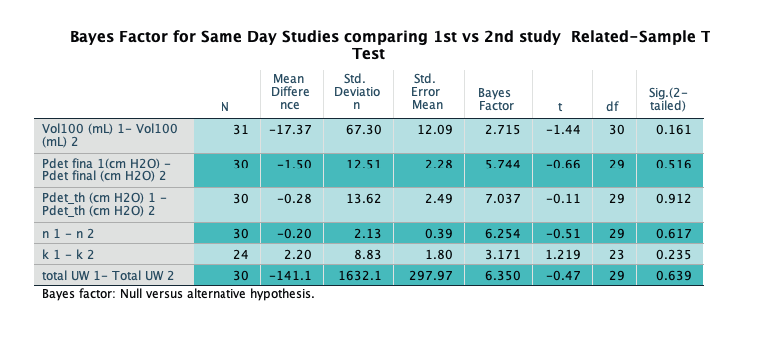Is Urodynamic Work a Reproduceable Measure in Neurogenic Bladders?
Eleonore Lieffrig, BS, Ben Press, MD, John Onofrey, PhD, Adam Hittleman, MD PhD, Israel Franco, MD.
Yale University, New Haven, CT, USA.
BACKGROUND: Urodynamic work is a measure that is described as the area under the urodynamic curve. In a recent publication by Tirayki et al it was used to calculate a new measure called theoretical end filling pressure. This was found to be more successful in predicting the probability of patients developing hydronephrosis over time than LPP or compliance in a study that included 115 patients. These results have major implications in that it is possible that we have found a better method of identifying potential upper and lower tract damage. Our aim was to identify if urodynamic work is reproducible by measuring the work in patients with who underwent 2 or more urodynamic studies on the same day. METHODS: An Irb approved retrospective review of the urodynamic studies conducted over the last 4 years. Urodynamic data was exported from urodynamic machines into a text delimited format. Python was utilized to perform a calculation of the area under the curve (UW). The volume, work and the Pdet theoretical (Pdetth) were recorded for each study. Bayes factors and p values were calculated for matched pairs. Moderate evidence or above (>3-10 or <0.1-0.33) were consider significant Bayes Factor (BF). ). Bayes factors were calculated with Null hypothesis/alternative hypothesis. P-values were calculated for comparison purposes and were considered significant if less than 0.05. Bland Altman analysis was performed to measure interstudy bias. Statistics were performed on SPSS ver 28 and Xlstat. RESULTS: We identified 62 UDS performed on the same day in patients with neurogenic bladders. Those studies were performed on 12 patients ranging in age from 7 -25 years old (13.3±7.3). Pdetth was found to have the highest BF=7.037 p=0.912) consistent with moderate evidence followed by Work (BF= 6.350 p=0.639) and Pdet terminal (BF=5.744 p=0.516). Terminal volume had anecdotal evidence of similarity with BF=2.715 p=0.161). Bland Altman analysis of Pdetth reveals that there was a bias of 7.43% (p=0.912 CI of bias=-20.5%-35.4%) compared to work BA analysis which revealed a bias=20.72 (p=0.639 CI of Bias=-9.9%-51.3%). The exponential value of the non linear regression of the work vs vol curve had a bias of 0.61% (p=0.617 CI of Bias= -32.6%-44.8%) which we have termed dynamic compliance index™. CONCLUSIONS: These findings indicate that Pdetth based on urodynamic work is a reliable and reproducible parameter that takes into account the dynamic compliance effect on multiple fills as described by Klausner et al and shows that the Pdetth does not change even though volume does change. These findings indicate that the Pdetth has a less than 10% change in work between studies helps reassure the urodynamicist that studies over time are comparable utilizing theoretical pressure and the dynamic compliance index™ which is derived from the shape of the work vs volume curves.

Back to 2023 Abstracts
